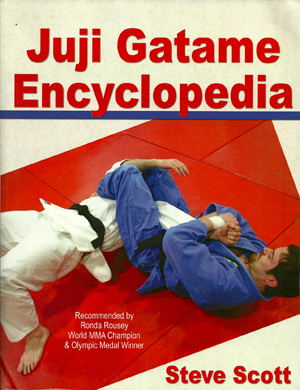Steve Scott’s newest book Judo Gatame Encyclopedia is out in bookstores, and it’s a whopper- over 400 pages on one Judo technique! As the author was working on it, and kept adding to it, he’d jokingly tell me that he had OCD, Obsessive-Compulsive Disorder. I’m no doctor, so I don’t whether he does have OCD or whether he’s simply being a detail-oriented, innovative educator. I’ll bet my money on the latter.
I don’t consider Judo Gatame Encyclopedia to be a pictorial book, although the book has thousands of photos. While “encyclopedia” certainly is an appropriate word for the book’s title, A Study of Juji Gatame is closer to what this book really is.
After studying this armlock for many years, it occurred to me that (as far as I could see), there was no “system” or “method” in the teaching of Juji Gatame.
This is the first book, of which this author is aware, that attempts to systematically present Juji Gatame as a singular subject and analyze its many applications into functional, real-world terms. From quite a few years of study and analysis, four specific and unique applications of Juji Gatame have been identified and are presented in this book.
The author encourages us to learn and teach Juji Gatame as a core skill, which makes sense considering how often it’s attempted and successful in competition. Of the four main applications his preference is to have novices work on the “spinning” version first, for sound coaching reasons.
The spinning application of Juji Gatame not only teaches the actual armlock, it also teaches fundamental skills of groundfighting such as learning how to move from the hips and buttocks, the shrimping or curling movements necessary for good groundfighting, learning spatial awareness, learning how to use the opponent’s (and one’s own) body or training uniform as handles to manipulate and control the opponent…
Besides the four main applications of Juji Gatame, the book presents Juji Gatame combinations, transitions from throws to Juji Gatame, and defenses and escapes from Juji Gatame. Of the combinations, Scott tells us:
Quite a few combinations are presented in this chapter, but not every combination can possibly be included. New combinations are constantly being seen in all levels of competition. Please take what is presented in this chapter and expand on it so that new, innovative (but above all, effective and functional) combinations involving Juji Gatame will be developed.
I admit that it took me a long time to read the book. I’m sure that if you’re half as analytical, critical and studious as I am, you too will be immersed in the book for a long time. Look beyond the pictures to discover the “system” or “method.” That’s really the most important part of the book, because without a system techniques are meaningless.
One final word about Judo Gatame Encyclopedia. While our promotion systems in the U.S. continue to reward judoka with high dan ranks merely for staying alive long enough rather than requiring work or knowledge that impacts the Judo community, Steve Scott’s Judo Gatame Encyclopedia is the type of research and product development for which high dan rank should be awarded.
P.S. For those of you who are new to my blog, you may want to read my review of Steve Scott’s Winning on the Mat: Judo, Freestyle Judo and Submission Grappling which I published in November 2011.


I would like to get this book. Culd you tell me….It is a great work, well done!!